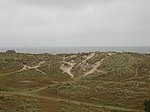Blood Hill wind farm
British power station stubsBuildings and structures in NorfolkE.ONNorfolk geography stubsPower stations in the East of England ... and 2 more
Wind farm stubsWind farms in England

Blood Hill is a wind farm near Hemsby in Norfolk, England. It is the smallest windfarm owned by E.ON; taking up 3 hectares. It has a nameplate capacity of 2.25MW which is enough to power 1000 homes at peak. There were 10 Vestas V27-225 kW turbines which were 30 metres tall and stand on top of Blood Hill. They are visible from the villages of Hemsby and Winterton-on-Sea. Blood Hill began operating in December 1992 and was one of the first windfarms in the United Kingdom. In 2000 a much larger 65m 1.5MW Ecotricity turbine was built adjacent to the site.In 2015 a repowering of the site saw the original 10 turbines replaced with 2 two Turbowind T400 wind turbines.
Excerpt from the Wikipedia article Blood Hill wind farm (License: CC BY-SA 3.0, Authors, Images).Blood Hill wind farm
Collis Lane,
Geographical coordinates (GPS) Address Nearby Places Show on map
Geographical coordinates (GPS)
| Latitude | Longitude |
|---|---|
| N 52.711944444444 ° | E 1.6669444444444 ° |
Address
Collis Lane
Collis Lane
NR29 4DS , Somerton
England, United Kingdom
Open on Google Maps









